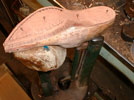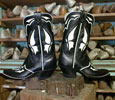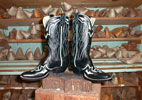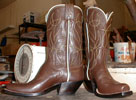There are many, many steps to completing a custom-made Western boot. Some you can see when you hold a boot in your hand, others are hidden from view once a boot is finished and ready to wear. Below is a summary of steps necessary to make a boot…click on any of the photos to get yourself a close-up view.
1. Measuring
- Take Foot and Calf Measurements

2. Design
- Choose leather
- Choose toe and heel style
- Design boot tops
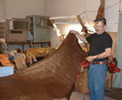
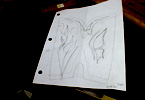
3. Boot Tops
4. Vamps
- Cut vamps and lining
- Stretch vamps and lining over crimpboards.
- Measure, trim and attach vamps and foot linings to tops
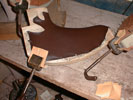

5. Counters
- Cut out hard leather counter and counter cover
- Slit, fit, and cement counter to boot top
- Skive and cement counter
- Sew counter and counter cover to top, trim
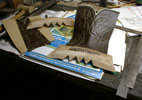
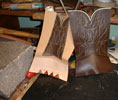
6. Side Seaming and Pull Straps
7. Fitting the Last
- Compare standard last to foot measurements
- Build up last (if necessary) with leather
- Smooth finish
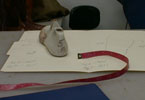
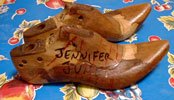
8. Insole
9. Lasting the boot and Toe Box
- Stretch wet vamp and counter over last
- Anchor with tacks
- Turn back vamp leather and position toe boxes
- Cement, dry and smooth toe boxes
- Pull and anchor vamp leather over toe boxes

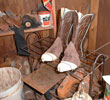
10. Inseaming, placing shanks and shank covers
- Punch holes through insole with awl
- Stitch inseaming thread through welt and insole
- Trim and flatten seam
- Sew in shank, sew or peg around heel
- Insert steel shank or flattened 40 penny nail
- Fill in shank and bottom of insole with leather pieces
- Shape/grind shank, then peg


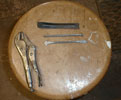

11. Attaching Soles and Pegging
- Trim welt to desired width
- Cement and trim sole to welt
- Sew and peg soles
- Ink and finish front of sole

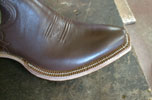

12. Stacking Heels
- Stack, cement and trim layers of heel leather
- Nail or peg heels, and add rubber heel cap
- Sand heels to final matching shape
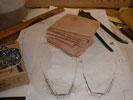
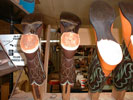
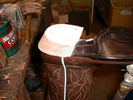
13. Finishing the Boot
(The boots shown on this page we made by me, Jennifer June, at Tex Robin’s bootshop in Coleman, Texas — July 10th to August 3, 2000.)
ACKNOWLEDGEMENTS
I’d like to thank Mr. Tex Robin for his editorial contributions to this feature…and more importantly, I’d like to thank Tex for helping me follow my dream of becoming a bootmaker through his generous offerings of time, expertise and personal support.
REFERENCES
How to Make Western Boots by Dennis Cottle and Dave McKinney. To order contact Mr. McKinney at (817) 688-2289.
The Texas Boot Book by David Reiff. Penguin Books, 1980. (Available from abebooks.com .)
.)
Awl
a small pointed tool for making holes in leather.
Back Stay
the strip of leather that runs up and down the back of the inside of the boot lining to stiffen and support the boot and hold up the top, which gets the most movement.
Beading
a slender, rounded strip of leather that encircles the top of the boot. The beading is most often made from the same material as the piping that runs down the side of the boot.
Cement
three kinds are used in bootmaking; rubber cement (temporary), press cement (sealing), and all purpose cement (long lasting).
Counter
the leather piece above the
heel of the boot, which is attached by
stitching to the vamp.
Crimping board
a narrow piece of wood, usually less than 1-1/2 inches wide, that looks like a tall tube sock. The wet vamps of boots are stretched and nailed to this board before they are attached to the other parts of the boot. Then the leather is left to dry for a day or two. This is an extra step before lasting to ensure that all the stretch or memory has been removed from the leather (preventing wrinkles from appearing at the curves of the boot over the top of the foot).
Edge Ink
(also called “heel dressing”) ink or dye that is used to stain the leather around the edge of the sole, shank area, and heel base.
Forty-penny nail
a nail that old-time bootmakers would beat flat and then shape to the dimensions of the wearer’s foot. The nail was then covered with a layer of leather, stitched, glued, and sometimes pegged between the insole and outsole to work as a shank that supported the wearer’s arch.
Heel
the part of the boot attached to the rear, or seat, of the sole. The heel comes in any shape and height imaginable and should be constructed to add support, comfort, and form to the overall boot design.
Heel Pad
A thin piece of leather that is glue on the inside of the boot, on top of the insole. Protects the insole at the heel from excessive wear.
Inlay
strictly decorative fancywork involving multiple layers and colors of leather. These may be overlaid or underlaid. Overlaid patterns are sewn over the principal boot leather, while underlaid ones are invisible, sewn in from underneath to produce a cutout window-type design.
Inseaming Thread
a flax or polyester thread that has been waxed so when you pull a stitch tight it will lock in position. This holds the welt to the boot.
Insole
the layer of leather between the foot and the outsole, or bottom, of the boot. The insole forms the inner foundation of the boot to which the outsole is attached.
Last
The model used to make all custom and factory boots. Until recently it was always carved from wood, but now often fiberglass is used. The toe, however, can be fastened to the end of the last in any style the customer desires. And small pieces of leather are shaped and glued and then sanded down smooth to compensate for any irregularities in a foot or changes that occur normally as a customer ages.
Overlay
strictly decorative fancywork involving multiple layers and colors of leather. These may be overlaid or underlaid. Overlaid patterns are sewn over the principal boot leather, while underlaid ones are invisible, sewn in from underneath to produce a cutout window-type design.
Outsole
the only part of the cowboy boot, besides the bottom of the heel, that actually has contact with the ground, unless you happen to get thrown off a horse or a bull.
Pegs
wooden pegs, little stakes of wood made from maple or lemonwood. These pegs, in rows of one to three deep, run along the arch (shank) of the boot down to the heel. Along with stitching and glue, they hold the insole and outsole together. Pegs are usually a sign of a better-quality boot, and you should also be able to see the tops of the pegs when you look inside your boots.
Piping
rounded strips of leather that run up the side seams of the boots. Sewn dead center between the back and front of the boot, piping can be in the same color or a contrasting color of leather to make the boot or its stitching patterns stand out more.
Pull Straps
straps that are used to assist in pulling the boot on. They can be on the outside or the inside of the boot in any size or shape.
Shank
the portion of the boot that is used as reinforcement for the wearer’s arch. Most bootmakers today use a thin, precut strip of eighteen-gauge steel, which is glued, whipstitched, or tacked in place. Some bootmakers still prefer to use a forty- or sixty-penny nail for support.
Skive
(…also known as “feathering” the leather) This is usually done when overlapping is required, as in overlay and inlay. The backside of the leather is scraped thin along the edges, or wherever the leather is too thick, with a sharp knife, lightly sanded for continuity, then quickly burned with a match or flame to remove any small, loose beads of skin that remain.
Sole
the only part of the cowboy boot, besides the bottom of the heel, that actually has contact with the ground, unless you happen to get thrown off a horse or a bull.
Toe box
a stiff piece of material that is placed in the top of the boot toe between the outer vamp leather and the lining to reinforce the shape. All toe boxes used to be made of leather until the advent of super man-made materials (a.k.a. “celastic”). The choice of toe box material is a topic of fierce debate among many custom bootmakers.
Vamp
the lower front portion of the cowboy boot that covers the foot. The vamp attaches to the counter in the back, and to the front parts of the boot top in the front.
Welt
a strip of heavy leather that is sewn around the lasting space of the upper and joins it to the insole. The sole is then stitched to the welt with a second seam. The welt is also known as the “rand”.


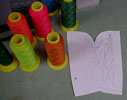

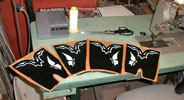
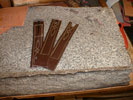





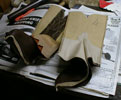
















.)


